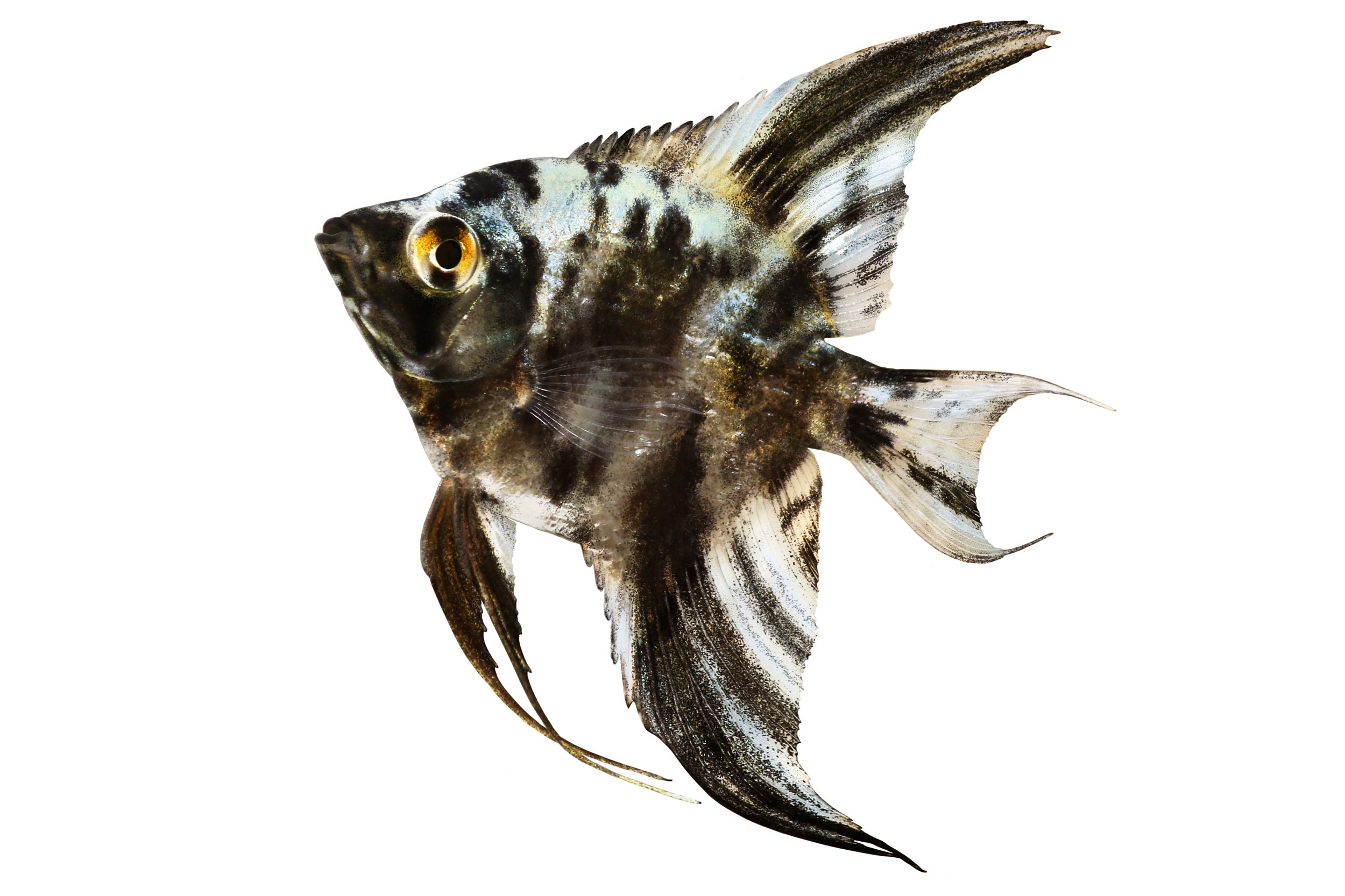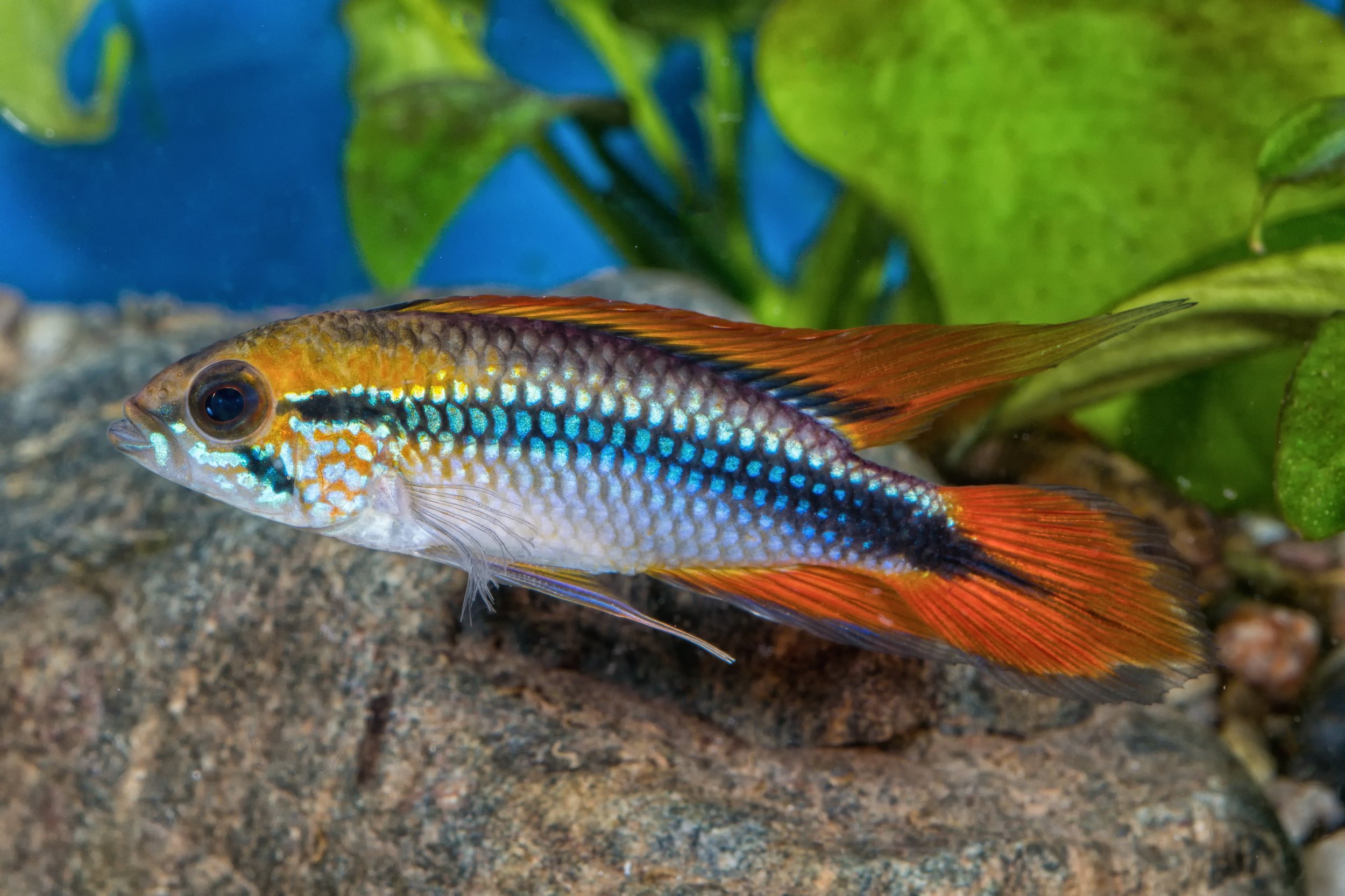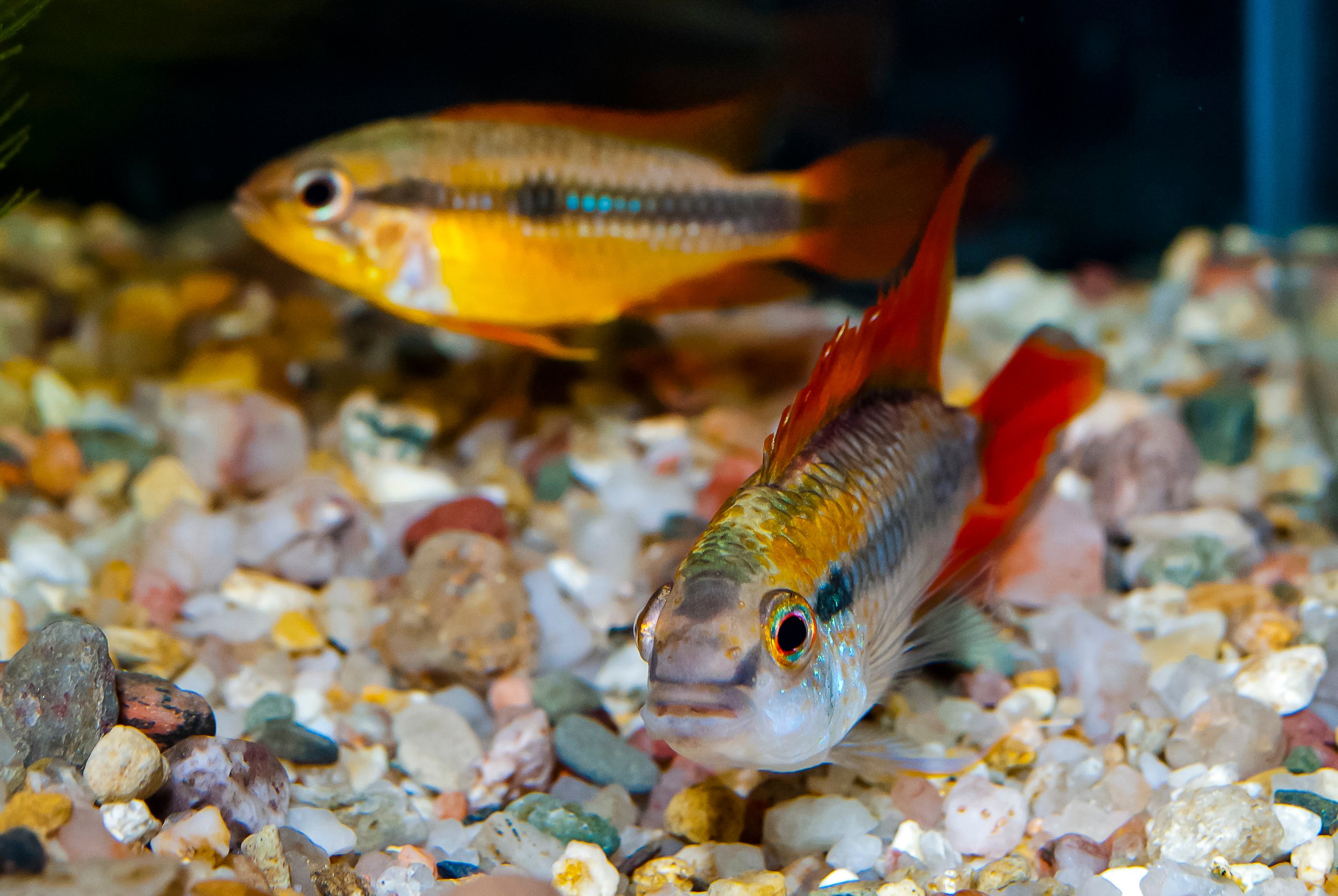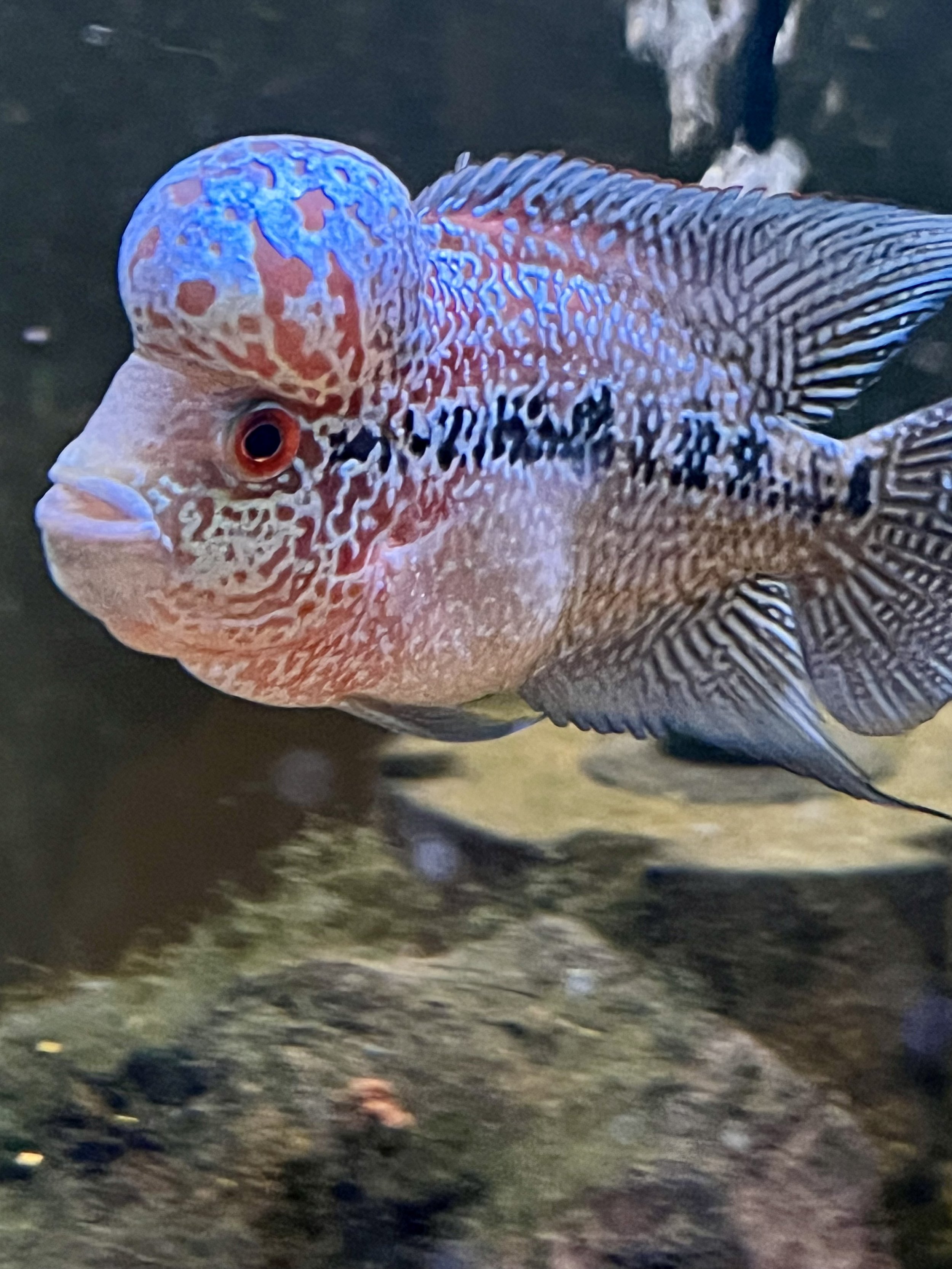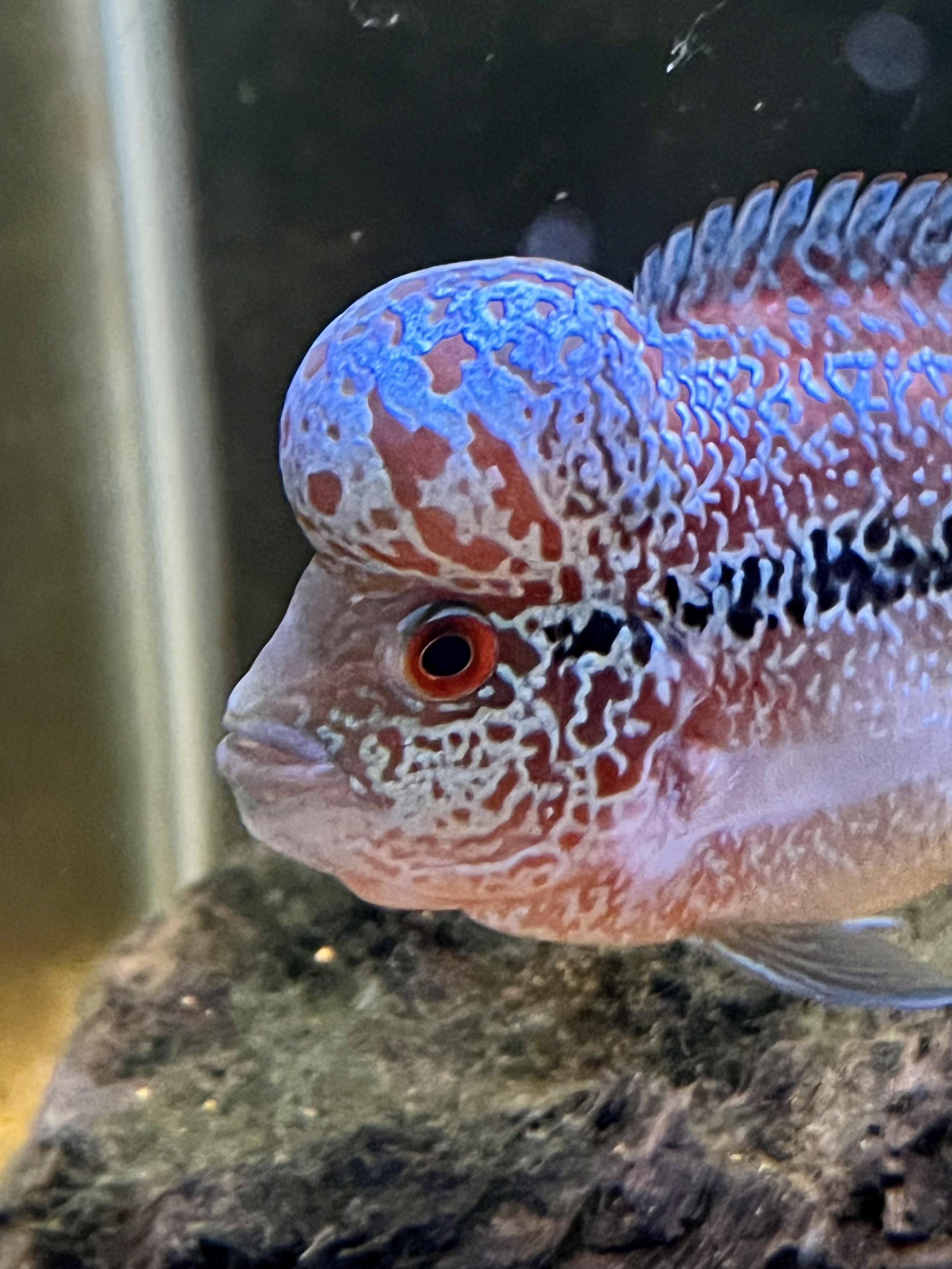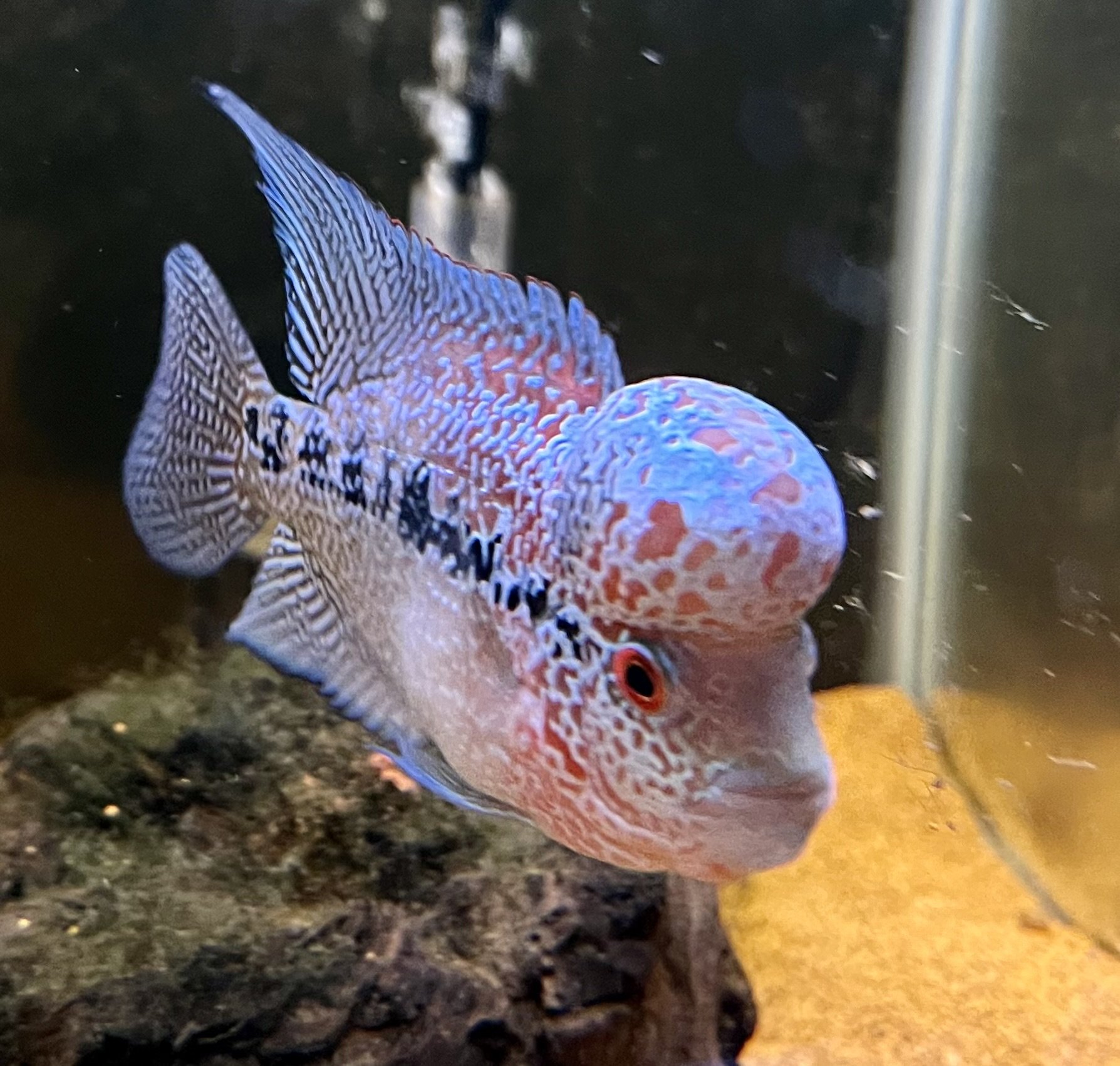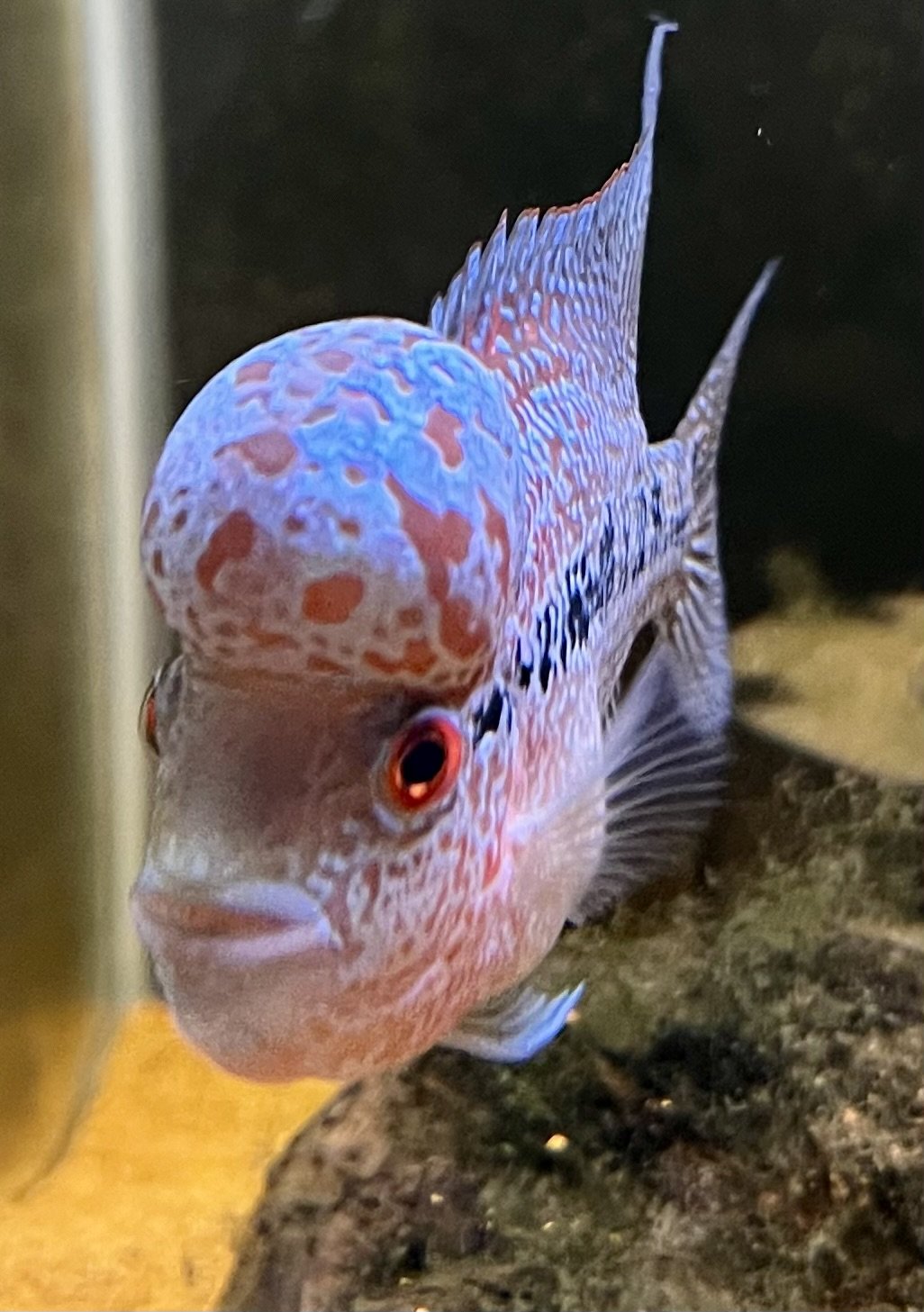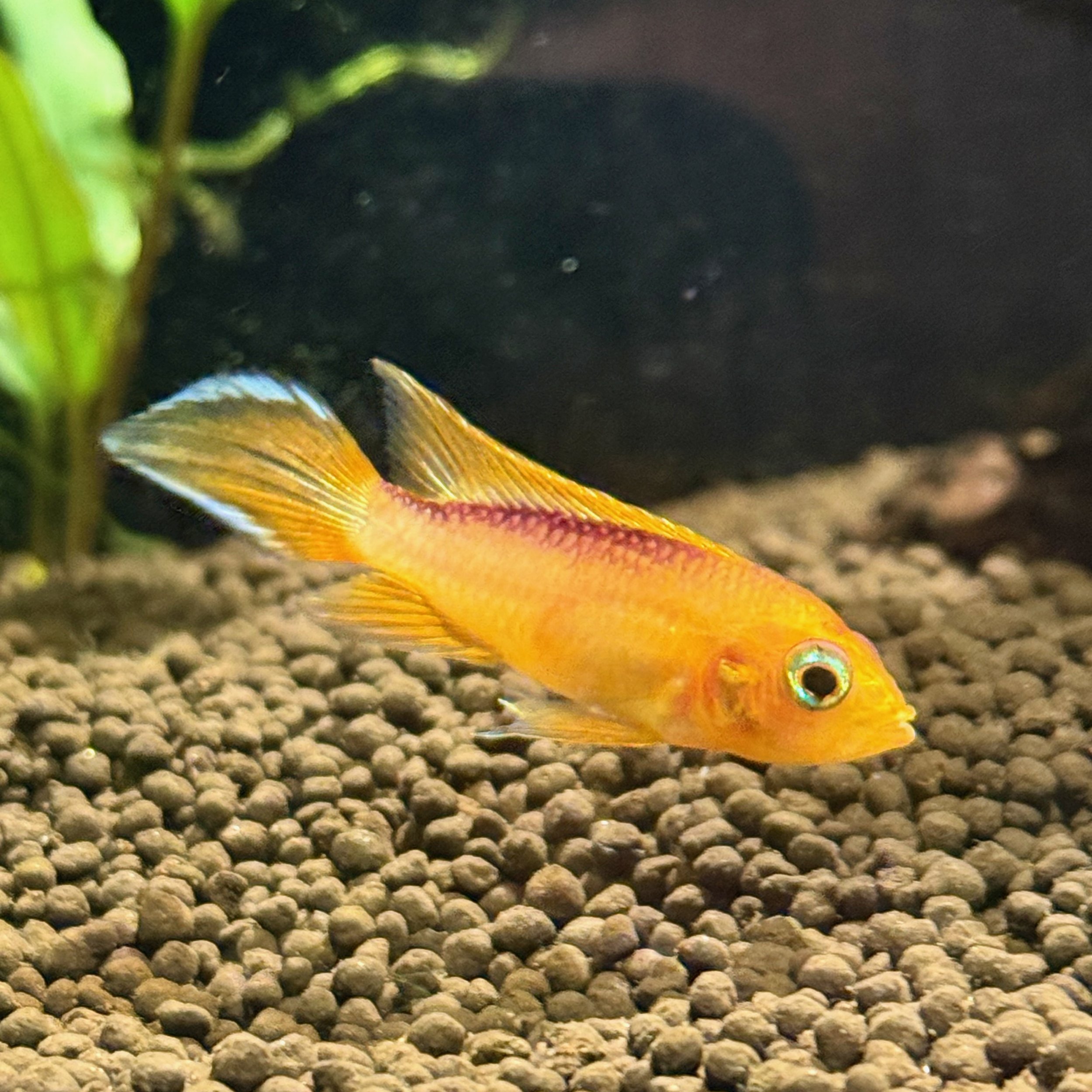 Image 1 of
Image 1 of


Geophagus Brasiliensis-2-3"
The Geophagus brasiliensis, commonly known as the Pearl Cichlid, is a hardy and colorful cichlid native to various river systems in South America, particularly in Brazil, Paraguay, and Uruguay. This species is known for its unique “earth-eating” behavior, where it sifts through substrate in search of food. The Pearl Cichlid’s stunning coloration, interesting behavior, and resilience make it a popular choice among cichlid enthusiasts, though it does require a spacious tank and careful tankmate selection due to its territorial nature.
Physical Description:
The Pearl Cichlid is named for its beautiful, pearly spots that cover its body, creating a shimmering effect under aquarium lighting. The body coloration can vary from light gray to greenish-blue, with a mix of red, orange, and blue hues on the fins and head, depending on the fish’s mood, diet, and environment. The fish has a robust body shape with a slightly rounded profile, and the fins are often elongated in mature adults. Males are typically larger and more vibrantly colored, with prominent fin extensions, while females are smaller and less colorful. Adult Pearl Cichlids can grow up to 8 to 12 inches (20 to 30 centimeters) in length, making them suitable for larger aquariums.
Aquarium Care:
Pearl Cichlids require a spacious aquarium of at least 75 gallons to accommodate their active swimming and digging behavior. They are best kept in tanks with a sandy or fine gravel substrate, as they enjoy sifting through it for food. Rocks, driftwood, and robust plants can be used to create hiding spots and establish territories, though care should be taken as these cichlids may uproot plants or rearrange decor due to their digging habits. They appreciate a tank setup with both open swimming spaces and shaded areas, allowing them to feel secure.
Water Parameters:
Geophagus brasiliensis is adaptable to a variety of water conditions, though it thrives in slightly acidic to neutral water with a pH range of 6.5 to 7.5 and temperatures between 72 to 82°F (22 to 28°C). They are tolerant of both soft and moderately hard water. Regular water changes and good filtration are essential, as these cichlids are sensitive to poor water quality. Due to their digging and active behavior, maintaining water clarity and removing waste is important for keeping the tank environment healthy.
Feeding:
Pearl Cichlids are omnivorous and enjoy a varied diet. They do well on a mix of high-quality cichlid pellets or flakes, supplemented with live or frozen foods such as bloodworms, brine shrimp, and daphnia. They also benefit from occasional vegetable matter, like blanched spinach or peas, which helps provide essential nutrients. Since they are natural substrate-sifters, they may consume small invertebrates or plant material in the wild, so offering a balanced diet that includes both plant and animal matter will keep them healthy and vibrant.
Temperament and Tank Mates:
Geophagus brasiliensis is a territorial species, particularly during breeding, and should be housed with care. They can be aggressive toward smaller or similarly-sized fish, especially if they feel their territory is threatened. Suitable tank mates include other large, semi-aggressive fish such as certain catfish, larger tetras, or robust South American cichlids like Severums or larger Acaras. Avoid keeping them with very small or delicate fish, as they may be harassed or seen as food.
Breeding:
Breeding Pearl Cichlids in captivity is relatively straightforward, as they are substrate spawners and readily breed if provided with the right conditions. To encourage breeding, it’s best to set up a separate breeding tank or ensure they have a secluded area in the main tank. The female will lay her eggs on a flat rock or other smooth surfaces, and both parents will guard the eggs and fry. The eggs hatch within 3 to 4 days, and the fry become free-swimming after about a week. At this stage, they can be fed with baby brine shrimp or finely crushed flake food.
Overall:
The Pearl Cichlid (Geophagus brasiliensis) is a beautiful, hardy, and interesting fish that brings a unique look and behavior to large aquariums. With their striking appearance, engaging digging habits, and relatively straightforward care requirements, they are a rewarding choice for aquarists who can provide them with a suitable environment and compatible tank mates. With proper care and attention to their needs, Pearl Cichlids can thrive, offering both color and character to any well-maintained freshwater setup.
The Geophagus brasiliensis, commonly known as the Pearl Cichlid, is a hardy and colorful cichlid native to various river systems in South America, particularly in Brazil, Paraguay, and Uruguay. This species is known for its unique “earth-eating” behavior, where it sifts through substrate in search of food. The Pearl Cichlid’s stunning coloration, interesting behavior, and resilience make it a popular choice among cichlid enthusiasts, though it does require a spacious tank and careful tankmate selection due to its territorial nature.
Physical Description:
The Pearl Cichlid is named for its beautiful, pearly spots that cover its body, creating a shimmering effect under aquarium lighting. The body coloration can vary from light gray to greenish-blue, with a mix of red, orange, and blue hues on the fins and head, depending on the fish’s mood, diet, and environment. The fish has a robust body shape with a slightly rounded profile, and the fins are often elongated in mature adults. Males are typically larger and more vibrantly colored, with prominent fin extensions, while females are smaller and less colorful. Adult Pearl Cichlids can grow up to 8 to 12 inches (20 to 30 centimeters) in length, making them suitable for larger aquariums.
Aquarium Care:
Pearl Cichlids require a spacious aquarium of at least 75 gallons to accommodate their active swimming and digging behavior. They are best kept in tanks with a sandy or fine gravel substrate, as they enjoy sifting through it for food. Rocks, driftwood, and robust plants can be used to create hiding spots and establish territories, though care should be taken as these cichlids may uproot plants or rearrange decor due to their digging habits. They appreciate a tank setup with both open swimming spaces and shaded areas, allowing them to feel secure.
Water Parameters:
Geophagus brasiliensis is adaptable to a variety of water conditions, though it thrives in slightly acidic to neutral water with a pH range of 6.5 to 7.5 and temperatures between 72 to 82°F (22 to 28°C). They are tolerant of both soft and moderately hard water. Regular water changes and good filtration are essential, as these cichlids are sensitive to poor water quality. Due to their digging and active behavior, maintaining water clarity and removing waste is important for keeping the tank environment healthy.
Feeding:
Pearl Cichlids are omnivorous and enjoy a varied diet. They do well on a mix of high-quality cichlid pellets or flakes, supplemented with live or frozen foods such as bloodworms, brine shrimp, and daphnia. They also benefit from occasional vegetable matter, like blanched spinach or peas, which helps provide essential nutrients. Since they are natural substrate-sifters, they may consume small invertebrates or plant material in the wild, so offering a balanced diet that includes both plant and animal matter will keep them healthy and vibrant.
Temperament and Tank Mates:
Geophagus brasiliensis is a territorial species, particularly during breeding, and should be housed with care. They can be aggressive toward smaller or similarly-sized fish, especially if they feel their territory is threatened. Suitable tank mates include other large, semi-aggressive fish such as certain catfish, larger tetras, or robust South American cichlids like Severums or larger Acaras. Avoid keeping them with very small or delicate fish, as they may be harassed or seen as food.
Breeding:
Breeding Pearl Cichlids in captivity is relatively straightforward, as they are substrate spawners and readily breed if provided with the right conditions. To encourage breeding, it’s best to set up a separate breeding tank or ensure they have a secluded area in the main tank. The female will lay her eggs on a flat rock or other smooth surfaces, and both parents will guard the eggs and fry. The eggs hatch within 3 to 4 days, and the fry become free-swimming after about a week. At this stage, they can be fed with baby brine shrimp or finely crushed flake food.
Overall:
The Pearl Cichlid (Geophagus brasiliensis) is a beautiful, hardy, and interesting fish that brings a unique look and behavior to large aquariums. With their striking appearance, engaging digging habits, and relatively straightforward care requirements, they are a rewarding choice for aquarists who can provide them with a suitable environment and compatible tank mates. With proper care and attention to their needs, Pearl Cichlids can thrive, offering both color and character to any well-maintained freshwater setup.
The Geophagus brasiliensis, commonly known as the Pearl Cichlid, is a hardy and colorful cichlid native to various river systems in South America, particularly in Brazil, Paraguay, and Uruguay. This species is known for its unique “earth-eating” behavior, where it sifts through substrate in search of food. The Pearl Cichlid’s stunning coloration, interesting behavior, and resilience make it a popular choice among cichlid enthusiasts, though it does require a spacious tank and careful tankmate selection due to its territorial nature.
Physical Description:
The Pearl Cichlid is named for its beautiful, pearly spots that cover its body, creating a shimmering effect under aquarium lighting. The body coloration can vary from light gray to greenish-blue, with a mix of red, orange, and blue hues on the fins and head, depending on the fish’s mood, diet, and environment. The fish has a robust body shape with a slightly rounded profile, and the fins are often elongated in mature adults. Males are typically larger and more vibrantly colored, with prominent fin extensions, while females are smaller and less colorful. Adult Pearl Cichlids can grow up to 8 to 12 inches (20 to 30 centimeters) in length, making them suitable for larger aquariums.
Aquarium Care:
Pearl Cichlids require a spacious aquarium of at least 75 gallons to accommodate their active swimming and digging behavior. They are best kept in tanks with a sandy or fine gravel substrate, as they enjoy sifting through it for food. Rocks, driftwood, and robust plants can be used to create hiding spots and establish territories, though care should be taken as these cichlids may uproot plants or rearrange decor due to their digging habits. They appreciate a tank setup with both open swimming spaces and shaded areas, allowing them to feel secure.
Water Parameters:
Geophagus brasiliensis is adaptable to a variety of water conditions, though it thrives in slightly acidic to neutral water with a pH range of 6.5 to 7.5 and temperatures between 72 to 82°F (22 to 28°C). They are tolerant of both soft and moderately hard water. Regular water changes and good filtration are essential, as these cichlids are sensitive to poor water quality. Due to their digging and active behavior, maintaining water clarity and removing waste is important for keeping the tank environment healthy.
Feeding:
Pearl Cichlids are omnivorous and enjoy a varied diet. They do well on a mix of high-quality cichlid pellets or flakes, supplemented with live or frozen foods such as bloodworms, brine shrimp, and daphnia. They also benefit from occasional vegetable matter, like blanched spinach or peas, which helps provide essential nutrients. Since they are natural substrate-sifters, they may consume small invertebrates or plant material in the wild, so offering a balanced diet that includes both plant and animal matter will keep them healthy and vibrant.
Temperament and Tank Mates:
Geophagus brasiliensis is a territorial species, particularly during breeding, and should be housed with care. They can be aggressive toward smaller or similarly-sized fish, especially if they feel their territory is threatened. Suitable tank mates include other large, semi-aggressive fish such as certain catfish, larger tetras, or robust South American cichlids like Severums or larger Acaras. Avoid keeping them with very small or delicate fish, as they may be harassed or seen as food.
Breeding:
Breeding Pearl Cichlids in captivity is relatively straightforward, as they are substrate spawners and readily breed if provided with the right conditions. To encourage breeding, it’s best to set up a separate breeding tank or ensure they have a secluded area in the main tank. The female will lay her eggs on a flat rock or other smooth surfaces, and both parents will guard the eggs and fry. The eggs hatch within 3 to 4 days, and the fry become free-swimming after about a week. At this stage, they can be fed with baby brine shrimp or finely crushed flake food.
Overall:
The Pearl Cichlid (Geophagus brasiliensis) is a beautiful, hardy, and interesting fish that brings a unique look and behavior to large aquariums. With their striking appearance, engaging digging habits, and relatively straightforward care requirements, they are a rewarding choice for aquarists who can provide them with a suitable environment and compatible tank mates. With proper care and attention to their needs, Pearl Cichlids can thrive, offering both color and character to any well-maintained freshwater setup.

